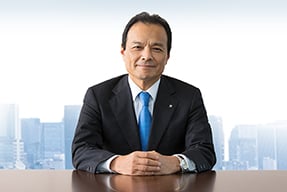Described below is the summary of Q&A session with institutional investors and securities analysts at the FY2012 results conference call held on Aug 10, 2012.
- Q1The higher unit premium in non-fleet auto insurance seems to have a positive impact on the results. Other than the rate revisions, are there any factors behind the unit premium rise?
- A1
In non-fleet auto insurance, the unit premium in 1Q FY2012 increased by 2.8% YoY, mainly due to the product and rate revisions in January 2012. The increase in number of new policies reflecting the recent strong sales of new cars also had an effect.
- Q2I think that PHLY's upward rate revisions for renewal polices reflect the declining underwriting profit. Is this decline due to causes other than natural disasters? Also, which lines did you raise premium rates?
- A2
PHLY's underwriting policy has been bottom-line results driven. As for renewal policies, premium rates and underwriting conditions are constantly reviewed based on past results. The losses from the record-breaking cold waves in northwestern US in 1Q FY2011 was also a factor for the rate increase. Property insurance and package-type policies including property coverage are the main lines subject to the rate increase.
- Q3For Kiln, revenue increased due to the rate hike in reinsurance business. Was there an increase in ceding premiums at TMNF?
- A3
As for domestic lines, the overall ceding premiums increased mainly due to the impact from the Great East Japan Earthquake and the change in the reinsurance arrangement.
- Q3(2)What did you mean by "change in reinsurance arrangement"? Have you changed your stance?
- A3(2)
There has been no big change, but we have made a minor adjustment of the arrangement considering the latest profit levels.
- Q4Following the reinsurance renewal in July, has there been any impact on the risk portfolio of your reinsurance business?
- A4
US natural disaster reinsurance renewals took place in July and the market showed a few percent increase in pricing. We have raised our pricing by almost the same level as the market.
- Q5What kind of natural disasters overseas would have a significant impact on your reinsurance business?
- A5
We think US hurricanes would have a significant impact not only on our reinsurance business, but also on our whole international insurance business.
- Q6The provision for outstanding claims reserve for auto shows a decrease this 1Q at TMNF. Is this because of the usage of the simplified calculation? If so, how should we interpret the actual underwriting results in auto? A6.
- A6
As pointed out, the outstanding claims reserve is calculated using the simplified method in 1Q. The YoY decrease in the provision is due to the refining of the calculation method from this year. If we calculate in the same way as last year, the amount of the provision in 1Q FY2012 would have been 4-5 billion yen more in total, mainly in auto and fire.
- Q7I think the simplified calculation method is also used for general underwriting reserves in 1Q. How did this affect the provision for the reserves in 1Q FY2012?
- A7
The simplified calculation method is used for lines in which the "underwriting result in the first year" is adopted to calculate the provision for general underwriting reserves. Although we cannot provide the impact from the simplification, the "underwriting result in the first year"
(*) for 1Q FY2012 in the applicable lines decreased by 2.6 billion yen YoY. (*) This "underwriting result in the first year" is the difference between unearned premiums and the actual "underwriting result in the first year," which shows the amount added on top of the unearned premiums."
- Q8I think the main reason for the significant profit growth in international insurance business was the recovery from large natural disaster losses last year. Excluding this effect, has the profitability improved?
- A8
In 1Q FY2012, combined ratio in international insurance business improved by 31 points YoY, and of this 31 points, 29 points were due to the recovery from last year's large natural disaster losses*. Remaining two points were owing to efforts of improving profitability and a decrease in large losses from causes other than natural disasters. Since it is only the first quarter of the year, we will continue to keep an eye on the underwriting results toward the end of the year.
(*) Including losses relating to floods in Australia, New Zealand and the Great East Japan Earthquake in 1Q FY2011 (January to March 2011)
- Q8(2)Does that mean there was a decrease in losses from natural disasters other than large natural disaster losses?
- A8(2)
Yes. Also, there was a decrease in large losses from causes other than natural disasters, which contributed to the profit increase.
- Q9In international insurance business, factors such as forex may affect financial accounting results based on Japanese yen. Is my understanding correct that there were no such special factors having an impact on 1Q FY2012 results?
- A9
In total, the forex effect came out almost even.
- Q10Regarding the acquisition of Delphi, goodwill of 36.3 billion yen was recorded in 1Q results. Is the 49 million dollars settlement cost paid to Delphi's shareholders who filed a suit taken into consideration in the recorded goodwill? Or, will it be recognized as a cost after Delphi's P/L consolidation in 3Q?
- A10
The settlement cost of 36.3 billion yen was taken into consideration in the calculation of the goodwill.
- Q11It seems that TMNL conducted over-the-counter bond options transactions, which were not done before. Were there any changes in its ALM policy?
- A11
There has been no change in TMNL's ALM policy.
- Q11(2)What was the purpose of the transactions?
- A11(2)
In order to appropriately control the interest-rate risks on the surplus, which is the difference between the present value of assets and liabilities, we have flexibly utilized financial instruments such as interest-rate swaps, in addition to spot transactions. As one of such instruments, we used option trading in 1Q.
- Q12You mentioned that the accident frequency in auto, excluding the impact from natural disasters, was about the same level YoY. Is this still true when you look at it on a monthly basis? Could you also please tell me the latest trend in July?
- A12
From April to mid-May, the accident frequency in auto increased YoY due to the reversal effect of the decreased traffic volume last year due to the Great East Japan Earthquake. This reversal effect faded away after mid-May and as a result, the accident frequency in 1Q FY2012 stayed at the same level YoY. In July, the accident frequency stayed almost the same level or slightly lower YoY until mid-month but rose slightly towards the end of the month, and July in total ended up with the same level YoY.
- Q13Please let us know the losses relating to the heavy rains in the Kyushu region this July.
- A13
We are aware of a loss of approximately 2.5 billion yen based on information available at this moment.
- Q14Whereas the full-year projection for TMNF's natural catastrophe losses is 30 billion yen, a loss of approximately 22.0 billion yen has already occurred in 1Q. Are you considering any revisions on your projections in light of the current situation?
- A14
As you mentioned, the amount of incurred losses relating to natural disasters has already reached approximately 22.0 billion yen in 1Q, a period in which natural catastrophe losses are generally small in an average year. However, since the projection of 30 billion yen was based on the average yearly losses in the past, we do not intend to make any changes in the projection at this moment.
- Q15Could you please tell us the level of economic solvency ratio (ESR) as of end of June?
- A15
We only announce the ESR twice a year (in 1H and full-year end). Given the fact that the Nikkei average fell by about 1,000 yen from March to June, it can be estimated that there was an approximately minus 4% impact on the ESR, because the ESR has a high sensitivity to stock prices.
- Q16It is said that premium rates in commercial sectors in the US are currently on the uptrend in general. Is PHLY's rate hike derived from following the market trend or its specific measures to improve profitability?
- A16
While the overall premium hike in the US market in 1Q FY2012 was about 4%, rate hike at PHLY has been well above the market average due to the company's efforts. The same can be said also to our other US businesses. In addition to the market trend, measures in underwriting to improve profitability led to higher rate rise than the market.
- Q17Currently the LIBOR problem is receiving a lot of attention. Have you underwritten any D&O insurance in your reinsurance business?
- A17
We have underwritten some D&O policies. However, sine we underwrite D&O insurance for financial institutes under strict disciplines, including due consideration to terms and conditions, the impact would be very limited if any.
- Q17(2)Does the problem has any impact on your primary business?
- A17(2)
Same as in our reinsurance business, we assume that the direct impact from LIBOR problem on our direct underwriting business is limited, considering limited underwriting stance and coverage.
- Q18At the subsidiary in Thailand, is there any development in incurred losses relating to the Thai Flood?
- A18
There is no increase in incurred losses at the Thai subsidiary at this moment.
- Q19Please tell us the reason for ordinary loss of 2.0 billion yen in 1Q at FL, which seems to be relatively small compared with the projected loss of 17.5 billion yen for the full year.
- A19
The projected ordinary loss of 17.5 billion yen for the full year includes several billion yen of an additional provision for underwriting reserves. However, the impact of this provision has not appeared yet in 1Q because the provision will be recorded at the end of the fiscal year based on the stock prices.
These information materials are prepared based on the currently available information for us and described subject to our predictions and forecasts carried out at the time of preparation.
It must be noted that what is described therein does not guarantee our future business performance and carries certain risk of misjudgment or uncertainty.
Accordingly, you are kindly requested to bear in mind that there may be a possibility of sizable divergence between the actual business performance in the future and that of our predictions or forecasts described therein.





